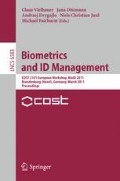Abstract
The automated forensic analysis of latent fingerprints poses a new challenge. While for the pattern recognition aspects involved, the required processing steps can be related to fingerprint biometrics, the common biometric model needs to be extended to face the variety of characteristics of different surfaces and image qualities and to keep the chain of custody. Therefore, we introduce a framework for automated forensic analysis of latent fingerprints. The framework consists of a generic process model for multi-branched process graphs w.r.t. security aspects like integrity, authenticity and confidentiality. It specifies a meta-model to store all necessary data and operations in the process, while keeping the chain of custody. In addition, a concept for a technical implementation of the meta-model is given, to build a container format, which suits the needs of an automated forensic analysis in research and application.
Access this chapter
Tax calculation will be finalised at checkout
Purchases are for personal use only
Preview
Unable to display preview. Download preview PDF.
References
Digitale Fingerspuren (2010), http://omen.cs.uni-magdeburg.de/digi-dak/
Bishop, M.: Introduction to Computer Security. Addison-Wesley Longman, Amsterdam (2004) ISBN 0321247442
Garfinkel, S.L.: Providing cryptographic security and evidentiary chain-of-custody with the advanced forensic format, library, and tools. In: IJDCF, vol. 1(1), pp. 1–28 (2009)
Raul, A.C., Dwyer, J.Z.: Regulatory Daubert: A Proposal to Enhance Judicial Review of Agency Science by Incorporating Daubert Principles into Administrative Law. Law and Contemporary Problems 66(4), 7–44 (2003), http://www.law.duke.edu/shell/cite.pl?66+Law+&+Contemp.+Probs.+7+%28Autumn+2003%29
Octave (2010), http://www.gnu.org/software/octave/
Zhang, D.D.: Automated biometrics: Technologies and systems, pp. 8–10. Kluwer, Boston (2000)
Vielhauer, C.: Biometric User Authentication for IT Security: From Fundamentals to Handwriting. Springer, New York (2006)
Garfinkel, S.L.: Afflib (2010), http://afflib.org/
Keightley, R.: EnCase version 3.0 manual revision 3.18 (2003), http://www.guidancesoftware.com/
Kohen, M., Garfinkel, S.L., Schatz, B.: Extending the advanced forensic format to accommodate multiple data sources, logical evidence, arbitrary information and forensic workflow. In: Digital Investigation, vol. 6(1), pp. 57–68. Elsevier, Amsterdam (2009)
Podio, F.L., et al.: Common Biometric Exchange Formats Framework, NIST IR 6529. NIST, Gaithersburg (2004), http://csrc.nist.gov/publications/nistir/NISTIR6529A.pdf
Larmouth, J.: XML Common Biometric Format, OASIS (2003), http://www.oasis-open.org/specs/
ISO/IEC 19794:2007: Information Technology: Biometric Data Interchange Formats, International Organization for Standardization, Geneva, Switzerland
Merkle, R.C.: A certified digital signature. In: Brassard, G. (ed.) CRYPTO 1989. LNCS, vol. 435, pp. 218–238. Springer, Heidelberg (1990)
W3C: XML Schema Part 1: Structures Second Edition (2004), http://www.w3.org/TR/xmlschema-1/
W3C: XML Schema Part 2: Datatypes Second Edition (2004), http://www.w3.org/TR/xmlschema-2/
Leach, P., et al.: A universally unique identifier (UUID) URN namespace. RFC 4122 (2005), http://www.ietf.org/rfc/rfc4122.txt
W3C: XML Signature Syntax and Processing Second Edition (2008), http://www.w3.org/TR/xmldsig-core/
W3C: Canonical XML Version 1.0 (2001), http://www.w3.org/TR/2001/REC-xml-c14n-20010315
Author information
Authors and Affiliations
Editor information
Editors and Affiliations
Rights and permissions
Copyright information
© 2011 Springer-Verlag Berlin Heidelberg
About this paper
Cite this paper
Kiertscher, T., Vielhauer, C., Leich, M. (2011). Automated Forensic Fingerprint Analysis: A Novel Generic Process Model and Container Format. In: Vielhauer, C., Dittmann, J., Drygajlo, A., Juul, N.C., Fairhurst, M.C. (eds) Biometrics and ID Management. BioID 2011. Lecture Notes in Computer Science, vol 6583. Springer, Berlin, Heidelberg. https://doi.org/10.1007/978-3-642-19530-3_24
Download citation
DOI: https://doi.org/10.1007/978-3-642-19530-3_24
Publisher Name: Springer, Berlin, Heidelberg
Print ISBN: 978-3-642-19529-7
Online ISBN: 978-3-642-19530-3
eBook Packages: Computer ScienceComputer Science (R0)

